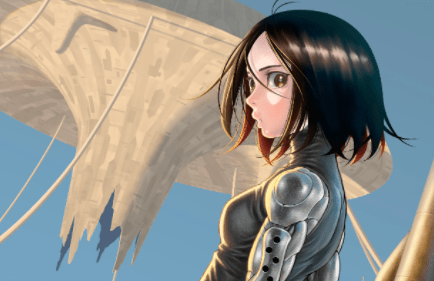First impressions for volumes 1-2 (Deluxe Edition Volume 1) of Yukito Kishiro’s manga series “Gunnm” or “Battle Angel Alita,” published in 2017 by Kodansha Comics.
Saved from the Scraps
Only the few and the fortunate are permitted to live in the shining space city of Zalem, a utopian metropolis which floats high above a desert wasteland. What trash and unnecessary dealings the people of Zalem find expendable are tossed into The Scrapyard, an enormous stockpile of waste below the city which is surrounded by a clustering of ghettos and shacks. This is where the rest of humanity–flesh and cyborg alike–eke out a living, surviving by grit and brute strength alone.
While scavenging a pile of discarded android parts, Daisuke Ido, a cyborg repairs doctor, finds the head of a young female cyborg amid the scraps. Dr. Ido builds a new body for the head and names her Alita. Although Alita’s memory upon activation is foggy and lost to her, she still wishes to stay by the good doctor’s side.
The caring relationship between the two is challenged when Alita discovers Ido’s night job as a hunter-warrior, a bounty hunter working for The Scrapyard’s government, and she decides to become one herself against Ido’s warning. While pinning down wanted criminals in the shadows of the slums, Alita awakens to her forgotten knowledge of fighting techniques. As it turns out, Alita is a warrior, though her origins are still unknown. With her newfound strength, Alita determinately fights for justice, recovering bits of her fragmented past to rediscover her original identity.
Lawlessness and Chaos
I love cyberpunk. Whether the clean-cut, glowing neon feel or the technologically clustered vision (as with Alita here), I enjoying seeing how different artists approach their worldbuilding. Whereas Ghost in the Shell is more cerebral-focused–showing how cyber enhancements in the brain transform humanity’s relationship with the Internet–Alita sticks to altering the physical body. The toughest of cyborgs that enjoy fighting in the arena are equipped with metal arms capable of lifting megatons. Might makes right in The Scrapyard.
When not admiring the glorious physiques of the various strongarm hunter warriors, we can look to the background art for cyberpunk influence. Often, pages of the comic will pass with little to no dialogue, leaving the reader to simply awe at the setting artwork and detailed landscape imagery. Yukito Kishiro structures the worldbuilding aspects of the series with elements of action or moments of self-discovery, imbedding the story of The Scrapyard within key character backstories or set pieces.
I’m especially referencing the ghastly yet vast and mazelike conditions of The Scrapyard’s sewer system–a seemingly bottomless world of gross infestation and hellish living for any creature. The bubbling bog’s curious plumes of stench contrast fantastically against the arid and metallic cityscape of the surface world. What binds them, however, is a prevailing sense of lawlessness and chaos.
If You Liked the 2019 Film, You’ll Love This
Despite having come to the manga from watching the 2019 live action film, I found Alita to read incredibly easy on its own. Each story element flows to the next well enough to warrant having the series on your shelf along with the film’s Blu-ray. Both the film and the manga have their own subtle differences (mainly concerning changes to the appearances of certain characters, or their omission entirely), but again, they both hold well on their own.
Perhaps the only major crime (as a film watcher) is the sad discovery that motorball isn’t in the manga at all! Or, at least not in the first couple volumes (*cries anyway*). Kodansha’s first Deluxe Edition volume ends on the film’s climax, so I’ll have to see how that cliffhanger is resolved in the manga. I wonder if it’s anything like the cool ending of the film . . .
Alita is, by and large, one of the most important titles in the cyberpunk genre. Its influence extends far beyond the main genre it belongs to, including the realms of action, adventure, science fiction, and even dystopia. What I discovered from my read of the first 10 or so chapters of the manga, however, was that all of the praise for Alita is well-deserved. Whether you liked the film as much as I did or not, you’re bound to love the empowering female narrative of the Battle Angel Alita manga even more.

“I believe that every human can choose her own way of life! We can choose to be ugly or beautiful!”
Alita
Afterword
I’m sure you’ll hear more about my Alita journey as I pick up more volumes, but we’re off to a fantastic start so far! Now the question is whether I should continue the series in the Kodansha Deluxe hardcovers or move to digital since, you know, it’s cost-effective (and saves a ton of shelf space)! I’ve got lots to think about.
One last thing! With all the cyborg skull-crushing and limb-smashing violence, Alita does lean more on the graphic side. Just wanted to let you know in case you are entirely new to the franchise. 🙂
Have you ever tried out this classic cyberpunk manga? Let me know in the comments! So far, I love the world and the characters in it, and that’s enough to keep me throwing money at this franchise. Thanks for reading these first impressions, and ’til next time!
– Takuto


